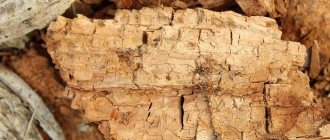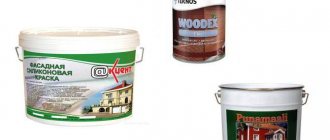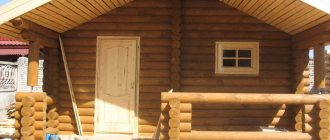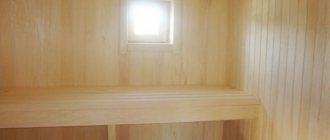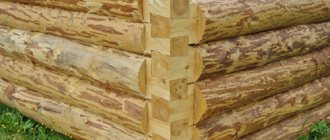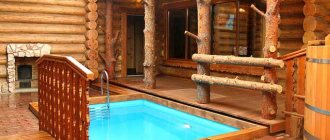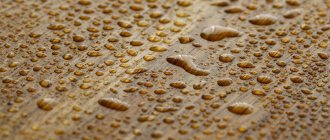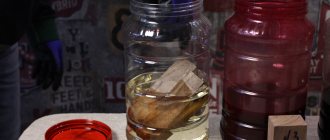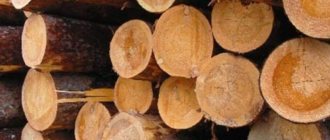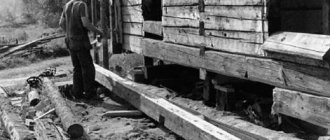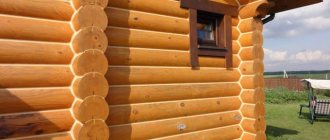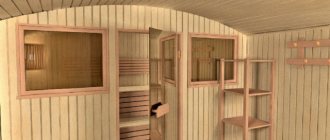How to stop wood rotting in your house?
Sooner or later, the owners of log houses, frame and timber buildings, including bathhouses, have to look for the answer to that question. Wood is a wonderful natural material, but, unfortunately, it is not resistant to negative external influences.
It is important to emphasize! If rot has appeared, it will not be possible to eliminate it completely without physically destroying the object or part of it. You can only stop its further spread. Accordingly, you need to start thinking about the fight against rotting at the design stage.
Why does a wooden house rot?
Rot is the final stage of mold development. Several reasons contribute to its appearance:
- The foundation is not waterproofed. This is especially true for regions with high groundwater level, periodic or constant flooding during spring floods.
- Raw lumber. Experts recommend using boards and timber with a moisture content of no higher than 12%. For only a felled tree this figure is at the level of 40%. Under natural conditions, drying takes at least a year. At sawmills, special furnaces are installed to speed up the process. They are additionally treated with antiseptics.
- Incorrect backing board selected. It separates the base from the lower crowns. The best material for this purpose is larch. Boards made from other types of wood will not prevent walls and floors from getting wet.
- Incorrect indoor microclimate. The rooms are practically not ventilated. In a house made of timber or logs, laundry is dried after washing. The owners love to take a hot shower, but did not take care of steam removal and high-quality ventilation.
- There are no vents in the cellar. If they exist, pits are not equipped. Rain or groundwater gets inside, shortening the life of the building.
- The roof overhang is less than the recommended values. Precipitation flows down the walls and onto the foundation. The situation gets worse if there are no blind areas.
- The lower crowns are made of low-quality material, are not impregnated with antiseptics at the preparation stage, or are located closer than 30 cm to the ground.
- The roof has not been waterproofed and the roof joints have not been sealed. They were not caulked, filled with tow, jute, or insulated.
Any of the above reasons, or even more so a combination of them, will lead to rotting of the house. How to stop this process will be discussed further.
How to speed up the process of wood decay
Sometimes the susceptibility of wood to rot can be regarded as a positive thing. If you know how to accelerate decay, you can use this feature of natural material to your advantage and force the fall of a tree or the removal of a stump.
Tips to speed up decay to remove dead trees and stumps are:
- Drill more holes in them a couple of centimeters deep. Insects will gather in these crevices, and moisture will accumulate during rainfall. Thus, the decay of the cellulose will accelerate, and the wood will decay much faster.
- You can speed up decay by sprinkling spores or pieces of mushrooms taken from already rotten wood of the same type onto a tree or stump.
- Water the soil around the unwanted trunk with nitrogenous fertilizers, which will provoke the development of parasitic fungi. After some time, you can feed the fungi with sweet water to stimulate the growth of their population.
All of these tips can be used at the same time. And, of course, you should water the trees more often and moisten the stumps. Then favorable results will not take too long to arrive.
What wood to choose for building a cottage
When making a choice in favor of one material or another, one must take into account not only its external beauty and ease of processing, but also its species and resistance to putrefactive processes.
Coniferous wood
It is especially popular in Siberia, the Far East, and the north of the European part of Russia. In the south, pine and spruce trees practically do not grow, which significantly limits their use in individual housing construction.
The most popular are:
- pine. The tree does not require special storage conditions. Has increased strength and resistance to rot;
- spruce. Without special regular treatment, it will not withstand constant contact with atmospheric moisture and various bugs. The result is rapid rotting and decomposition;
- fir. Features soft wood. If you do not treat it with antiseptics in a timely manner, the fir beam will become covered with mold even before the foundation pit is prepared;
- cedar. Resistant to rotting, including when used in conditions of constant high humidity;
- larch. It has a very dense structure into which water does not penetrate.
Hardwood
There are also options recommended for construction and those that are best left at the sawmill:
- oak. Does not crack or warp. If a log remains in water for a long time, it will only become stronger;
- birch. This tree is characterized by medium density combined with high strength. But this does not get rid of decay;
- aspen. It has a soft structure that is not susceptible to rotting. Aspen is rarely used for exterior decoration, but there is a place for it in a bathhouse or sauna;
- ash. In terms of strength characteristics and resistance to rotting, it is not much inferior to oak;
- poplar. It is generally not recommended to be used as a building material. It warps quickly, and the boards become covered with cracks after drying;
- Linden. It has soft wood that does not require much effort when processing. But buildings are almost never built entirely from it. Most often used for finishing steam rooms.
If you decide to buy a house made of 6 by 9 timber according to the given characteristics, you should prefer oak, ash, larch or cedar. But these breeds are expensive and not accessible to everyone.
Another significant moment! Trees grown in northern conditions are more resistant to freezing and unfavorable external conditions. Their wood is denser. Trees growing in the south are often weaker. Without periodic treatment, they will not withstand exposure to moisture or woodworms.
Houses made of timber
from RUB 325,000
Frame houses
from RUB 283,000
Country houses
from RUB 266,000
Stages of the destruction process
Destruction of wooden poles in different conditions: a – in sandy soil, b – in dense clay soil; c - pile in a pond.
To assess whether it is possible to use the affected wood for technical purposes, it is necessary to determine at what stage of decay it is. The process of wood rotting goes through 4 stages:
- Initial. Mushroom mycelium does not affect the tree shell. The wood still retains its structure and strength, but only changes color to olive, lilac-gray or red-brown.
- Developed. Mother-in-law or pits appear in the wood. Light stripes and films of mycelium appear on a brown background.
- Ultimate. The tree completely loses its strength, crumbles or splits into chips. The color completely corresponds to the type of decay.
- Mechanical destruction of wood, hollow formation.
When working with wood, you should always take into account the tendency of this building material to be affected by fungus and, depending on the desired result, prevent decay or accelerate decay.
Where to start protecting a wooden house from rot
Just purchasing the “right” material for construction is not enough. The points listed below must be taken into account.
Selecting a location
It is not advisable to place the house in a lowland, at the foot of a hill. Otherwise, the foundation will constantly get wet, and waterproofing will have to be laid in several rows so as not to constantly stop rotting. If there is no other option, high-quality drainage is required to drain storm and flood waters.
Foundation height
It is recommended to equip a monolithic foundation for a frame or timber cottage. The height above ground level is at least 30 cm. To guarantee the protection of the tree, it is better to lay the ground floor of brick and concrete. It can also be used as a basement, underground garage, or storage room.
Planting
Bushes and trees should not come into contact with the walls or roof of the house. Numerous bugs living in the crown should not be given an additional opportunity to move to the log house.
Minimum decorative elements
Carved platbands look beautiful on windows, porches, and front doors. But moisture collects in numerous protrusions, recesses, and depressions, provoking the development of mold, and then rot.
It is advisable to install visors over the windows, and all wooden surfaces that do not have protection should be treated with water-repellent compounds. Drainage and thoughtful ventilation will help speed up the evaporation process.
Time interval between construction and start of finishing
If the builders have just left the site, you cannot immediately start plastering, painting the walls, covering them with plasterboard or clapboard. At least six months are allocated for the final drying and shrinkage of the tree. If this period is not met, significant amounts of moisture will be “locked” inside the load-bearing structures. Very soon they will appear in the form of black spots of mold, and then rot.
Roof, hydro and thermal insulation
A mandatory element of the slopes is a full-fledged drainage system with gutters, funnels, and pipes to drain water away from the foundation. The roof itself should have a protrusion within 40-60 cm to protect the walls from direct sunlight.
The vapor barrier film is always placed at the beginning of the heat flow, where the temperatures are positive. The thermal insulation membrane must be located at the end of the heat flow. In this case, condensation will not accumulate in the supporting structures. Another condition is the sealing of the joints of timber or logs, the point where the pipe exits from the stove or heating boiler to the roof.
Finnish composition
- Flour - 700 gr.
- Iron sulfate – 1500 gr.
- Table salt – 350-400 gr.
- Lime pigment – 1500 gr.
- Water - ok. 9 liters.
The Finnish solution is prepared in the same order as the Swedish one.
When using the solutions, they try to keep them hot, but paint them so that the surface does not overheat in the sun. It is advisable in the afternoon, so that at night the solution can be absorbed into the wood and not dry out ahead of time. The solutions are applied in 2 layers, without prior priming.
Wood is one of the most commonly used materials in construction and furniture production. And in order to last as long as possible, it needs proper care. There are quite a large number of factors that have a bad effect on wood and render it unusable, worsening the external qualities of the material or destroying its internal structure. Therefore, it is important to know how and what to treat wood with so that it can be used for as long as possible.
How to treat a house to protect it from rot
The methods listed earlier in this article help prevent or stop the rotting of a timber building at the structural level. But there are also a variety of preparations, varnishes, and paints that can increase the service life of an already built cottage or bathhouse if treated with them in a timely manner.
All preparations offered by the industry are intended for preserving or preserving wood. The first option is applied before the start of construction work. Wooden parts are immersed in special tanks with potent compounds for several days. Then thorough drying is required. The result is reliable protection from both rot and various insects.
Not all suppliers and sellers offer wood that has undergone such processing. Coating with antiseptics is much more often used. The owner of the property can also carry out the procedure, subject to the precautions specified by the manufacturer.
Types of antiseptics
All offered drugs belong to one of the following groups:
- Water soluble. The main advantage is quick drying after application and the complete absence of unpleasant odors. They can be used to process wood inside a building. For external surfaces, it is better to choose compounds that are more resistant to water.
- Water repellent. They can be used to protect against rotting in bathrooms, kitchens, and bathhouses. They are not afraid of constant contact with water, but after application the room needs long-term ventilation. The antiseptic has a very strong and unpleasant odor.
- Based on volatile components. All surfaces are covered with a thick and durable film. It does not let air and moisture in and prevents the formation of mold.
- Oil based. These preparations can be used to treat completely dried wood. They have good adhesion. Once dry, the resulting film cannot be scratched or scraped off with a knife. It is not recommended to use such compositions in living rooms. And it won’t be possible to cover it with varnish or paint in the future due to the complete lack of adhesion to the base.
- Combined. In most cases, they contain components that protect logs not only from rotting, but also from fire.
It is quite difficult to single out specific drugs. A lot of brands are produced both in Russia and abroad. Thus, with the help of “Ekolan” you can not only prevent the appearance of blue stains, but also emphasize the structure of the tree. The base is acrylic, great for exterior decoration.
Separately, it is worth highlighting such a drug as “Rogneda Biosept”. With its help, you can protect not only wood, but also concrete or brick cellars from mold. The only limitation is that it cannot be used if the surfaces were previously coated with alkyd paints.
Of the aqueous formulations, Tikkurila Homeenopoisto and Sadolin Bio Clean from Finland are especially popular. But special care is required when handling them due to the formation of toxic gas. Be sure to follow the manufacturer's recommendations regarding proportions. Otherwise, you can completely whiten the wood.
What to consider when buying an antiseptic
In order not to repaint or treat the entire house every year, you need to pay attention to the following points:
- For exterior work and subfloors, difficult-to-clean preparations are suitable. In most cases, when applying them to wood, you will have to use a respirator due to the unpleasant odor, but the validity period is designed for 30-35 years;
- Special impregnations and varnishes will help protect logs, fences, and flights of stairs not only from rotting, but also from deformation, excessive shrinkage and shrinkage;
- purpose. Outdoor formulations are more toxic. Indoors, preference should be given to water-soluble pastes or solutions. They have to be renewed more often, but there are completely no pungent odors that do not disappear for weeks;
- application features. Some mixtures can be poured into a spray bottle and treated with surfaces. Others will have to be applied with a brush or roller. If you need to protect a cottage with two or more floors from rot, the work will require both time and effort;
- Many manufacturers offer compounds that simultaneously protect against bugs, rot, and fire. This type of processing is cheaper. But the question of feasibility remains controversial. Some experts believe that the savings may be imaginary. It is better to buy separate preparations for each case and apply them sequentially, thoroughly drying the previous layer.
Swedish composition
- Flour (rye or wheat) – 1100 gr.
- Iron sulfate – 500 gr.
- Table salt – 500 gr.
- Dry lime coloring pigment – 500 g.
- Natural drying oil – 500 gr.
- Water - ok. 9 liters.
A paste is prepared from flour and 6 liters of water (boiling water). Then salt and iron sulfate are sequentially dissolved in a hot paste, and pigment is added. Then, with vigorous stirring, add drying oil and the remaining hot water. Water is added to paint consistency. The solution is used immediately after preparation.
Dyeing as a method of combating putrefactive processes
Paint is traditionally used for the following purposes:
- giving the product, in this case made of wood, an attractive appearance;
- protection from waterlogging or drying out, fight against rot.
But to solve the problems it is important to consider:
- Adhesion or penetration. The higher it is, the longer the paint layer will stay on the log or beam. If adhesion is low, cracks will appear in a maximum of a year and the protective properties will be lost.
- Covering power. It is determined by the quality and quantity of pigment. If the indicator is at the proper level, it is enough to apply the paint in one layer.
- Drying time. It determines when it will be possible to move on to the next stages of finishing.
- Elasticity. This criterion is especially important when carrying out outdoor work. If the paint is not flexible, it will crack when exposed to sunlight or moisture.
When choosing paint for anti-rot treatment, it is important to consider not only the previously listed factors, but also the composition. So, oil options are time-tested, but they take a long time to dry and smell bad. In all respects, alkyd modifications are a good alternative to oil modifications, and they are also characterized by increased elasticity.
Water-based ones cannot be used for street work. But indoors they dry out in a couple of hours, without leaving even a hint of smell. One of the varieties is acrylic. After drying, a durable film remains on the surface of the wood, which is not afraid of temperature changes.
Another option is emulsion. Coloring pigments are added to varnish or oil. The covering power is low, but there is good elasticity. At the same time, it dries for a long time and leaves behind a strong smell.
Possible errors and difficulties
If mistakes are made during the process of replacing structural elements, the structure may collapse.
Safety precautions are also important and must be strictly observed at any construction site.
Frequent mistakes when carrying out restoration work are:
- work in rainy weather;
- use of low-quality materials;
- discrepancy between the sizes of old and new logs;
- lack of treatment of new elements with antiseptics;
- errors in caulking seams;
- use of faulty equipment.
Important! To avoid mistakes and possible consequences, it is recommended to consult with a specialist before starting work.
Homemade methods of protecting wood from rot
Not everyone trusts industrial developments.
Many people prefer to make do with “home remedies,” some of which were known centuries ago: 1. Copper sulfate
It is in the arsenal of any summer resident who takes care of his garden. With proper use of copper sulfate for many years, you will not have to worry about the appearance of black spots on sawed logs or beams. It penetrates deeply into the pores, closing them to water.
But the application is significantly limited by the presence of negative properties.
If the wood is constantly or periodically heated, the vitriol will evaporate. Volatile components will enter the air and may cause poisoning. This is how it is recommended to treat outbuildings and external walls. Work with gloves and safety glasses and take reasonable precautions. 2. Firing
This method has long lost its popularity, although it is considered environmentally friendly. Simply wet the logs with water and burn them with a blowtorch or gas torch until the wood acquires a uniform brown tint.
The principle of operation is that excess moisture evaporates from the upper layers. The structure becomes more dense and impervious to moisture. The appearance of mold or mildew on the surface after firing is possible, but rotting processes are practically excluded.
The main reason why firing is not popular is the technical complexity of implementation. You can burn the logs before they are laid in the walls. Yes, and this will take many days. In addition, the material loses its natural attractiveness. The characteristic yellowish tint is replaced by a not very attractive brown. Even the original layout of a house made of 9 x 9 timber will not save you. The building will look unassuming.
3. Silicate glue
You can add additional strength to wood in basements and rooms with constant high humidity by applying silicate glue (liquid glass). But the wood must first be well dried.
The composition contains no components harmful to humans. A significant limitation is the inability to paint or varnish the wood in the future. The surface is shiny and absolutely smooth.
4. Drying oil with added manganese
Allows you to simultaneously carry out antiseptic treatment and create a barrier to moisture. A durable film is formed on the surface, preventing the formation of cracks.
5. Oak bark concentrate
This drug will prevent the appearance or development of rot for a long time. The only drawback is that light wood will become darker after processing. A house made of 150 by 150 timber will look different than planned.
6. A mixture of linseed, hemp and tung oils
It was originally used to protect wooden musical instruments from moisture. After drying, a film similar to varnish appears on the surface, since when the components come into contact with oxygen, the polymerization process starts.
7. Beeswax
This option requires significant expenses, but is completely worth it. Due to the absence of chemical impurities, wax is recommended for use in bedrooms, including children's bedrooms, when it comes to protection against rotting.
How to Remove Old Oil Paint
You can try to remove old paint by applying a 2% caustic soda solution to it. After some time, the paint will soften and can be removed with a scraper. The solution of caustic soda can be replaced with a solution of laundry soap and turpentine in a ratio of 1:2.
Using a hair dryer may also help. When exposed to hot air, the paint peels off. Before doing this, you can lightly spray the wood with water. Water causes old paint to swell when exposed to temperature.
There are also various solvents and solutions for removing old paint of different types on sale. For example ATF-1 or SP-7.
Main rules
Remember, so that your frame house does not rot in 5 - 10 years, you can and should follow three basic rules.
1. Completely dry frame house elements
Only dry materials should be used in the house. Do not allow the use of EB boards during turnkey construction. “Turnkey” means complete interior finishing.
2. Sealing the house from the inside
Use only high quality films. Pay more attention to gluing seams. It is especially important to observe this point when the house is being built for permanent residence (all year round).
3. Ensure moisture-proof outside
As the saying goes, “measure twice, cut once.” Check the film that you will install on the external walls; it should be a film FOR EXTERNAL WALLS.
You can find out how to arrange and do all this correctly on the Internet or by watching the video presented on our website. If any video does not open, write to us about it.
And, perhaps, the most important thing.
If you don’t know how or don’t want to build a house yourself, then special attention should be paid to choosing a company that builds frame houses. Before you make any transaction, be sure to check all available data about the company you have chosen.
Video: Why frame houses rot
Why do frame houses rot? With this video we are trying to answer this question, since today the warranty on frame houses is three years, sometimes five years. And most of the houses built now will rot within 8-10 years. How to avoid this and what you need to know to avoid getting caught, watch our video.
Video: Confession of a builder / Why ventilate the frame? Video: Frame house UNDER DEMOLITION!
Attention! All comments, reviews, links and email addresses are subject to mandatory verification by a moderator.
If your link or email is useful for our resource, it will be published. SPAM, ref. links, etc. - will be deleted!
Are you sure you want to report this review?
Messages, Comments, Reviews (2)
You are viewing: Rotting frame house
At first
5/5 (2)
Max (msk, Moscow) writes...
Now you can’t trust builders at all, unless these builders are, of course, your own friends whom you trust and who won’t let you down.
Reply to the author
2 May 2022 21:19
Arina (Kursk, Kursk region) writes...
In 2022, an 8x6 frame house and a 4x6 bathhouse were built. Everything was built from planks of natural moisture. This spring we remodeled the window in the bathhouse and everything turned out to be rotten. Both the boards and the wool are covered with mold or rot, I don’t know how to say. It is clear that everything will have to be disassembled and remade. But the main question is this. We understand everything about the bathhouse, but what to do with the house? The house has expensive finishing, both inside and outside, it’s a shame to pick apart it, but it doesn’t give you any peace. Is it possible to see what is going on inside the walls without dismantling the walls? Maybe there is some technique?
Administrator:
Hello. Of course, there is special equipment, video cameras, for example (video endoscopes and endoscope cameras). But even with the help of special cameras, you will not be able to see the full picture of what is happening there. To get a good look you will have to drill a lot of holes and this will not solve the issue 100%. It is quite possible that the situation with your house is not as critical as with the bathhouse. If you are not sure that the walls are in good condition, then find the opportunity to dismantle a small section of the finishing and see what is there.
Reply to the author
4 May 2022 10:29
Page 1 of 1
Saltpeter
Of its six types, only potassium (sodium) and ammonia can help remove old wood. Moreover, paradoxically, both are valuable fertilizers. And they are widely used by gardeners for growing cereals, as well as for feeding some fruit-bearing trees. But in large doses, both types turn into strong poison.
Sodium nitrate has a very good, negative effect on the root system of the plant. But there is no point in simply adding more to it - you will have to wait more than a year for the result. The composition will act much faster if you introduce it into the created hollow. You don’t even have to dilute the substance in water, but regularly add it inside in dry form.
Ammonium nitrate is made from urea. The substance not only kills living plant cells, but also promotes their rapid decomposition. And if you influence the roots, then after a while they will simply turn into fertilizer. The product can be scattered dry around the tree. Or regularly water the roots with a saturated solution.
Meaning of the word log house
Examples of the use of the word log house in literature.
An abandoned cart in the alley, a woodcutter in the yard with an ax hastily stuck into it and a half-hewn board nearby, worn-out bulls lazily plucking low-growing grass in the middle of the street, an overturned bucket near the well frame - everything indicated that the peaceful flow of life in the farmstead was unexpectedly disrupted and that the owners, leaving their business unfinished, disappeared somewhere. While cutting a log onto a well frame, he heard a woman's howl and lamentations for the dead.
In the clarity and balladic simplicity there is such a bottomless comprehension of the impending disaster: In the thickets, in the huge swamps, By the tin river, In the shaggy and dark log houses There are strange men.
Not seeing anything in front of him through the oil-stained armored glass, squeezing the squealing brakes, he waited for the impact on some kind of log house, on a fence, on a hut.
In the clearing, the remains of a charred log house were smoking, a cauldron for boiling brine lay overturned on its side, and scattered salt glinted on the withered grass.
In the middle of it is a weed pit, littered with a pile of rotting animal and plant waste, and several wooden log houses that serve instead of cesspools and are intended for pouring out slops and waste from all over Okhotny Ryad.
The Yenisei stood still, stood, the ice turned sour, soured, crunched at first sleepily, lazily, as if the river was stretching, but nevertheless it warmed up, stirred itself up, drove a stripe, cracked the ridge, and immediately it became whitely visible as rearing, squeezed ice, and it breathed steam there the stale water swirled and rushed along the cracks and breaks to the shores, and the river immediately became crowded, and it began to flow in all directions, and had already pushed one and another ice floe onto the shore, there the hummock began to pile up on a stone bull, and it broke winter road, dark markers floated, and the yellow pretzels of the road twisted, twisted along the guard, breaking off pieces from them, chewing with fangs of ice with a crackling sound, and from above, from distant places, even steeper and more forceful water poured in, and pure ice with someone's fenced-in ice holes, paths, forgotten bridges, heaps of ice, with wood chips - they laid a log house and a log with an ax stuck in it on the ice - they rolled the log house to the shore in a hurry and did not have time to grab the log with the ax, no, they managed, they dragged it, almost reached the shore, but ice
Log houses were made, heaped with stone, and tools were placed on these log houses.
At the hour when the light-bearer comes out to announce morning to the earth, and the dawn spreads over the sea like a golden robe, the frame under Patroclus has decayed, and the crimson flame has gone out.
If it weren’t for Andrei, I would have given you the memory to know how to move your ears around the torture log cabins.
It oozed in cheerful streams through the tight logs of the log house: large icy drops fell thicker and thicker on Danila’s head and shoulders every minute.
There are also traces of wrecks - tarred boards of carbass bottoms, fragments of oars and masts with decayed ropes, and traces of destroyed unknown hearths - weightless lace blocks of platbands, logs of rolled out log houses and other sad remains of human mortal existence.
Of the three dozen Far Ones, no more than half remained, baring their fangs, they fought desperately, sandwiched by the Trappers between the black log house and the tower.
I was a coachman for ten years, I know how to build a log house, even with crowns without corners, cultivate a field, I can blacksmith and carpenter, I can also sew kobednik’s shoes.
They show us a very dense forest - in a word, a whole grove, you can even buy it for a log house - and the prince comes out into this very grove, sad and sad, as if he was trading something that happened or had a falling out with his hostess.
Source: Maxim Moshkov library
Classification of drugs
A large number of available antiseptics have been developed that are used for treating wood and have a surface and deep effect. The most common inorganic, organic and combined antiseptics are:
- Inorganic mixtures are the least toxic and are widely used in private households. These include sodium fluoride and fluoride salts, alkali metal chromates and dichromates, copper sulfate, a mixture of boric acid and its sodium derivative - borax. The list of inorganic antiseptics is wide and depends on specific tasks, local characteristics and weather conditions.
- Organic antiseptics are resins that are predominantly coke-chemical in nature, heavy insecticides (protection against insects) and fungicides (stop the growth of fungus). Such mixtures are used for processing industrial structures and are rarely used in agriculture due to significant toxicity. Less harmful impregnations containing gasoline and turpentine components can be used for external protection of residential buildings.
- Combined antiseptics are mixtures of solvents and target components (resins, insecticides, fungicides). The resulting mixtures are often no less dangerous than their individual organic components, and therefore are rarely used in everyday life. Most often in production when splicing wood. The development of chemical and environmental production has led to the emergence of new varieties of commercial drugs that are less harmful to humans and the environment.
The photo shows different types of antiseptics
Organic Inorganic Combined Hard to wash out
Advantages of Neomid 440 Eco impregnation
The colorless, safe antiseptic composition Neomid 440 Eco is intended to provide protection to wooden materials from the effects of various types of mold and fungi indoors and outdoors. Also to prevent the formation of moss, lichen, algae and the invasion of various wood-boring insects on wood. Antiseptic impregnation Neomid 440 Eco can eliminate existing contamination of the material. This composition provides the treated surface with a long period of protection, which is about 25 years.
Neomid 440 Eco can be used for application to wood located in a room with high air humidity (basement, bathroom, cellar, etc.). After the treatment, the structure of the wooden material does not change. In the future, it can be easily painted, glued, etc.
